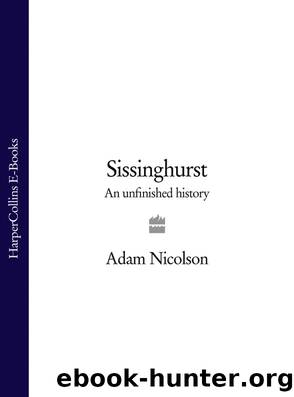Sissinghurst by Adam Nicolson

Author:Adam Nicolson [Adam Nicolson]
Language: eng
Format: epub
ISBN: 9780007380725
Publisher: HarperCollins Publishers
Published: 2015-06-10T16:00:00+00:00
EIGHT
Glory
I PLUNGED BACK into Sissinghurst’s past, to look for the aspects of Sissinghurst that stretched beyond modern tensions and difficulties. I hoped to find Sissinghurst in its glory, in the sixteenth century, when it leaped up out of its rooted and Kentish condition and became for a moment a place of power and glamour. Intriguingly it turned out that Sissinghurst was never a more troubled place than then.
In the decades before 1500, the Wealden villages around Sissinghurst boomed. Money surged into them. The Weald was not part of the strictly regulated, seigneurial world of the good lands in the north of the county, and so the people here had long nurtured their liberties. The ability to rent and buy land; small dues owed to distant overlords; a habit of dividing property between all children; a poverty in the soils which created the need for a mixed system of farming: all of this made for a radical independence of spirit and a competitive, entrepreneurial world. There was a long history here of rebellion and resistance to authority, stretching back to the Peasants’ Revolt in 1381. Nowhere else in England did the new Protestant ideas take such quick and vivid root. William Tyndale, the great early translator of the Bible, in exile in the Low Countries, had contacts in Cranbrook, had his works smuggled into England by Cranbrook clothiers and for a while was living in the Antwerp house of Richard Harman, a Cranbrook man, dissenter and merchant. When Thomas Wyatt led a rebellion against Bloody Mary in 1554, no parish contributed more men than Cranbrook to his fiercely Protestant following. And this was one of the parishes in the next century from which a steady stream of Puritans would leave for the freedoms of Massachusetts.
A modern land market was fully operating by the fifteenth century. Estate agents, auctions, gazumping, short-term rentals, buying to let, speculation and mortgages were all at work in the Kent Weald, embedded in a rapidly modernising and commercialising world. Business and farming were deeply intertwined here. Cranbrook was the largest town in Kent (with over two thousand inhabitants) and the parishes around it were one of the busiest parts of England. Most of it was occupied by a free peasantry, who farmed holdings made up of small fields or closes, almost never in single blocks but scattered across parishes and between them. It was cattle country, with few sheep and only a little arable. Wheat and oats were grown but no barley and no hops. Beef cattle were the source of cash. A trade was maintained with north Kent, along the old droveways, by which beef walked north and barley came south. No records survive for the farm at sixteenth-century Sissinghurst, but they do for another gentry estate belonging to the Culpepers at Bedgbury in the neighbouring parish of Goudhurst. There in 1542 they planted 14 acres of wheat and 34 acres of oats, about 20 acres lay fallow and there were about 160 acres of grassland
Download
This site does not store any files on its server. We only index and link to content provided by other sites. Please contact the content providers to delete copyright contents if any and email us, we'll remove relevant links or contents immediately.
| Photo Essays | Photojournalism |
Shoot Sexy by Ryan Armbrust(17142)
Portrait Mastery in Black & White: Learn the Signature Style of a Legendary Photographer by Tim Kelly(16484)
Adobe Camera Raw For Digital Photographers Only by Rob Sheppard(16387)
Photographically Speaking: A Deeper Look at Creating Stronger Images (Eva Spring's Library) by David duChemin(16161)
Bombshells: Glamour Girls of a Lifetime by Sullivan Steve(13109)
Art Nude Photography Explained: How to Photograph and Understand Great Art Nude Images by Simon Walden(12348)
Perfect Rhythm by Jae(4621)
Pillow Thoughts by Courtney Peppernell(3397)
The Book of Joy by Dalai Lama(3218)
Good by S. Walden(2915)
The Pixar Touch by David A. Price(2740)
Fantastic Beasts: The Crimes of Grindelwald by J. K. Rowling(2543)
A Dictionary of Sociology by Unknown(2518)
Humans of New York by Brandon Stanton(2379)
Read This If You Want to Take Great Photographs by Carroll Henry(2303)
Stacked Decks by The Rotenberg Collection(2270)
On Photography by Susan Sontag(2130)
Photographic Guide to the Birds of Indonesia by Strange Morten;(2088)
Insomniac City by Bill Hayes(2084)
